| 1 | Australia’s most common sea snake |
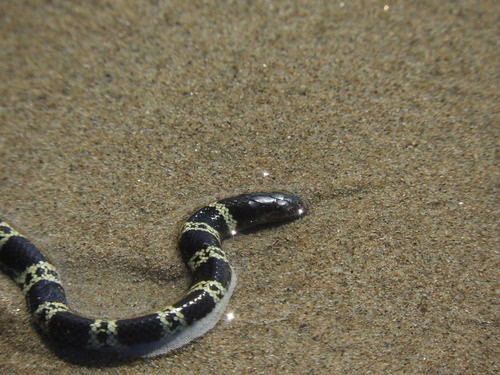
The elegant sea snake is a species mainly of Australian waters, which ranks perhaps as the most common member of the Hydrophis (true sea snake) group. This snake covers a vast stretch of coastal Australia, even exceeding the greater sea snake. On the west side, there have been sightings in offshore Perth, while to the east, their range extends down to Sydney. They’re also found in southern Papua New Guinea.
At a record of 2.6 metres, Hydrophis elegans is one of the longest sea snake species, just falling short of the yellow sea snake (Hydrophis spiralis) at 3 metres. They’re also the single most commonly found stranded on Australian beaches. In a survey from 1995 to 2015, they accounted for 122 of 451 sea snakes washed ashore, just surpassing the greater sea snake at 119/451.
Elegant sea snakes are often found in 2 metre deep seawater, but also swim up freshwater estuaries. They’ve been recorded well into the Daly and Mary rivers of northern Australia, and the record was a beam trawler which caught a Hydrophis elegans 12km upstream in the Burnett River of Queensland.
In northern Australia, Hydrophis elegans is one of the most frequently caught sea snakes in prawn trawler bycatch. This species can also be found wading around small coastal creeks, maybe ones you’d unwisely explore after escaping from your parents for a couple of hours by the beach.
| 2 | Absorbs oxygen from seawater |
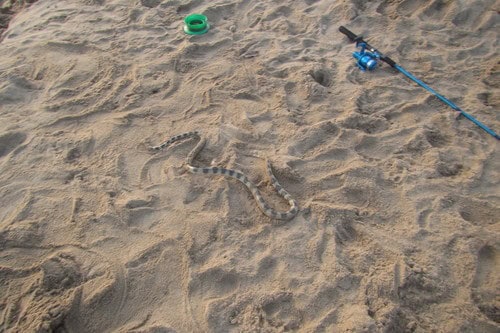
As usual for the family, juvenile elegant sea snakes have more distinct, sharper patterns, with 35-55 vivid black bands covering a beige underlay. These bands blur together with age. Elegant sea snakes generally have a black or dark grey head, versus olive for the greater sea snake. These two often coexist (such as in Shark Bay), so this is a useful ID sign to remember.
Elegant sea snakes can supply over 20% of their oxygen requirements via cutaneous gas exchange, absorbing oxygen molecules from the water, via their skin, and releasing carbon dioxide molecules in return. However, they must still surface for oxygen regularly.
Elegant sea snakes are able to hold their breath for at least 45 minutes, and likely up to 2 hours. It also depends on temperatures. A 2016 study on 10 elegant sea snakes, as well as 12 Shaw sea snakes, found that in warmer ocean temperatures, the duration of dives was shorter and the number of surfaces was greater.
| 3 | Reaches 145 metres deep |
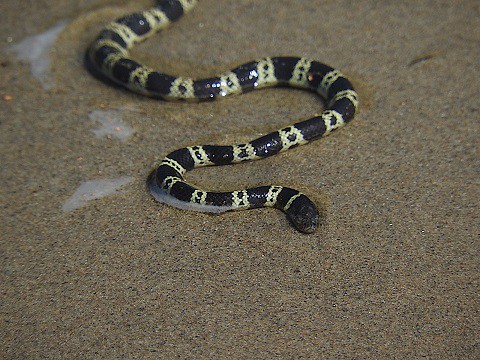
During prawn trawler operations for banana prawn and tiger prawn, elegant sea snakes are regularly caught at depths of 30-40 metres. Elegant sea snakes are confirmed to reach 80 metres down, as recorded 32km off the coast of Bundaberg, Queensland.
A case from 2006 offered even more clues. The location was Broome, West Australia, and the Galathea 3 expedition was sailing over waters 145 metres deep. The team collected a Hydrophis elegans, and immediately after capture, it regurgitated a benthic eel. Benthic means a fish that forages along the seabed, meaning that the Hydrophis elegans likely captured it while 145 metres underwater. The exception would be if this was a rogue eel sent adrift by underwater currents.
That said, they don’t shy away from shallower waters either. Elegant sea snakes are regularly found on sandy coastal areas 2 metres deep, including where swimmers may stray to. While capable of hunting in deep waters, Hydrophis elegans venture to shallow coastal bays to give birth, using them as a sea snake nursery. As usual, this species lays live young, and in decent totals of 17-30. It’s believed that juveniles remain in these safe refuges for two years while they hone their skills.
| 4 | Neurotoxic venom, but tiny quantities |
Hydrophis elegans venom causes rapid paralysis in fish and prawns. Like its Elapid cousins, it’s heavily neurotoxic in order to prevent fish from fleeing. No fatal bites have been confirmed in humans. The quantities of venom are minuscule, so tiny that milkings often fail. Reported yields include 5.5-8.9mg, with a maximum of just 24mg.
Yet the LD50 toxicity score has been estimated at 0.27mg, which defeats virtually all rattlesnakes, and several true cobras. A 2012 study tested 6 sea snakes and found it to be the most potent in rats, defeating ornate sea snakes in second.
Elegant sea snakes eat fish entirely, and when tested on frog nerve preparations, the venom had zero neurotoxic effects. Yet the venom did affect mammal nerves, despite not featuring in their diet. There are no amphibians in the open ocean, yet there are mammal predators. Perhaps this snake has evolved to take down dolphins, licking their lips at the thought of trying their 32nd sea snake species, fantasising about the differing tastes. In rat studies, no local necrosis was observed, nor proteolytic effects, so the elegant sea snake’s venom may be purely neurotoxic.
| 5 | Confirmed albatross food |
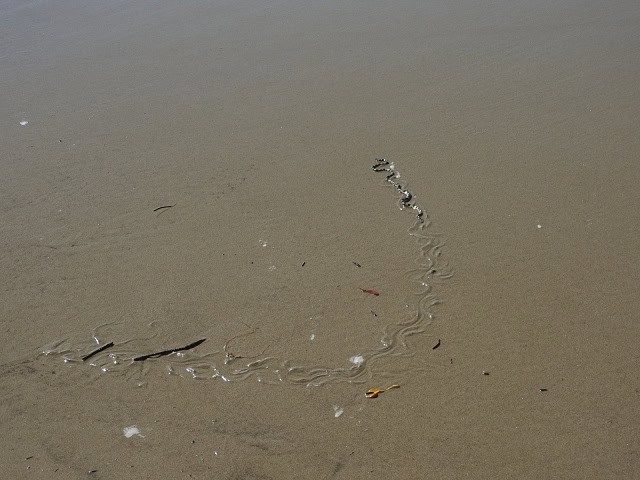
In August 2002, Hydrophis elegans became the first ever sea snake to be confirmed prey for an albatross. A white-capped albatross was found washed up on a beach on Frasier Island, Queensland, 5km south of Dilli Village. Analysis revealed it to be a young female, with a badly bruised wing, little to no fat reserves, and many missing feathers. Scientists noticed a lump in its abdomen, and after making a small incision, an elegant sea snake fell out, with a length of 1.47m excluding the tail.
Albatrosses eat a mixture of fish and cephalopods, particularly mackerel and red bait. These are both hunted on the sea surface using plunging manoeuvres, and stolen from the catch of passing fishing vessels.
Clues such as a bruised wing showed that the albatross died by drowning, and not due to a bite by Hydrophis elegans. Until 2002, no sea snakes had ever been found in their diet. But an extra clue was that most previous diet studies on albatrosses had been conducted in southerly seas, where elegant sea snakes are only occasional refugees.
| 6 | Hydration expert |
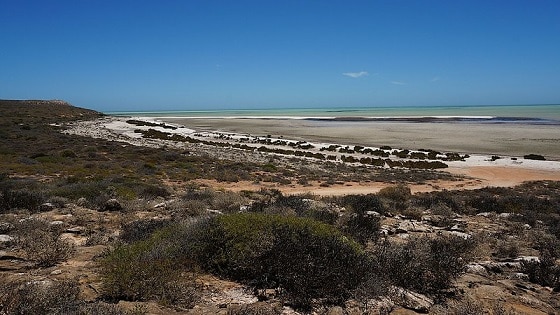
In 2015, Hydrophis elegans was one of a few species studied in order to solve the riddle of how sea snakes stay hydrated while living in salt water. Scientists from the University of Florida zoomed around two large river mouths in western Australia in a motorboat, capturing sea snakes using handheld nets. They captured six dozen snakes from 5 species, also including Shaw’s sea snake and Hydrophis zweifeli. These were immediately placed in a freshwater tank in the lab.
Surprisingly, only 4 individual snakes immediately drank water. The snakes were then kept in the open air, resulting in their gradual dehydration, turning them into a crispy snack of a serpent. But the snakes were surprisingly relaxed about replenishing their moisture. There was no panicked rush – the elegant sea snakes only began drinking once their body mass had plummeted 29% below the baseline.
Shaw’s sea snakes begin drinking at 26% loss and H. zweifelei at 27% loss. However, two species refused to drink any freshwater, even at the end of the study when they’d reached nearly 40% loss: Peron’s sea snakes and Aipysurus mosaicus. Imagine a human being losing 25% of their weight from water evaporation alone – you’d make for a great extra on Universal’s latest The Mummy remake.
| 7 | Goes weeks without drinking |
The scientists concluded that sea snakes (including the elegant) had even more extreme resistance to dehydration than thought, particularly compared to land-based snakes, a forced evolutionary compensation for living in sea water. Quote: “Thirst in these species is significantly less sensitive than in other species“.
A separate group was placed in a salt water tank, causing them to lose a gigantic 1-3% of their body mass daily. Elegant sea snakes are skilful enough to overcome this, for years on end (they’re confirmed to reach at least 15 years). Not one of the sea snakes drank salt water, even while their bodies shrivelled up. The scientists also remarked how despite losing over 25% of their weight via dehydration, the appearance of the sea snakes remained fine. They didn’t look grotesque, they remained sleek.
Unlike a banded sea krait, elegant sea snakes never flop down onto rocky shores to relax. They spend most their time in salt water, except when venturing to estuaries. One source of drinking water while in the ocean is freshwater “lenses” that form on the surface, immediately post rainfall, remaining afloat initially due to the heavier weight of the salt water below. Sea snakes are attuned to these pools, and will poke their heads above the surface and drink from them.
| 8 | Eats an eel-rich diet |
There’s long been debate over the elegant sea snake’s diet. Some argue that it feeds on eels exclusively, while others argue that this is nonsense. In 2002, scientists headed to Shark Bay, an aquatic wildlife hub in western Australia. This is an official Unesco world heritage site, which is believed to have been dry land 6000 to 8000 years ago, only flooding thanks to rising sea levels.
The team gathered 123 elegant sea snakes, including 106 adults and 17 juveniles. They found 46 prey items within, of which 25 were identifiable (not a half digested pile of mush). The verdict was clear: all 25 prey belonged to the Ophichthidae snake eel family.
The nearby greater sea snakes were far more varied, eating parrotfish, eels, scorpionfish, and perciformes. The scientists noticed other clues, such as Hydrophis elegans having a more elongated head than greater sea snakes, designed to probe into dark gaps where eels could be lurking. The elegant sea snakes tended to forage over the sandy flats where snake eels may burrow, instead of the nearby seagrass beds.
| 9 | Forced to eat smaller meals |
Compared to males, female elegant sea snakes ate larger meals. Greater sea snakes also ate larger meals than Hydrophis elegans, despite being significantly shorter. This was down to their larger heads.
In a 1983 study, elegant sea snakes were much less strict. In 5 prey items determined, Hydrophis elegans ate 2 snake eels (Ophichthidae), 1 moray eel (muraenidae), 1 whiting (Sillaginidae), and 1 eeltail catfish (plotosidae). The eel addiction was less prevalent, but every fish recorded was elongated. There were no bulky catfish, for example. Elegant sea snakes are limited by their small heads and must eat fish with similar body shapes to their own, with eels not being their exclusive prey, but definitely their favourites.
In 2002, the scientists also used complicated methods to calculate their ages. They found that the 46 adult male elegant sea snakes ranged from 2.3-15.4 years, while the 60 adult females ranged from 2.9 to 10.9 years. Males had the longevity advantage, but for average age, the reverse was true: the adult male average was 2-4 years while females averaged at 4-6 years.
The Shark Bay study revealed the elegant sea snake’s lifestyle: foraging over the sandy flats, and resting above the seagrass beds. Meanwhile, greater sea snakes spent almost all their time over seagrass beds. Their differing diets meant that the two had little reason to interact.
| 10 | Shark-dodging strategies |
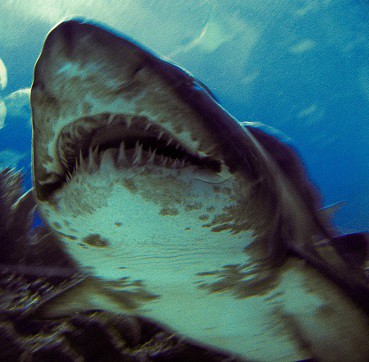
Tiger sharks are the number one nemesis of several aquatic serpents. Greater sea snakes are proven to retreat to inner seagrass beds during warm weather, in which numbers of patrolling tiger sharks rise. A 1982 study found that tiger sharks particularly favoured olive sea snakes, and banded sea kraits.
As for elegant sea snakes, they made up 50% of one small tiger shark’s diet. A Shark Bay study from 2008 confirmed how they are attuned to this deadly predator. The elegant sea snakes were careful only to forage in sandy flats during low tide, when they were too shallow for tiger sharks to access. During high tide, they retreated to the safety of seagrass beds, despite prey being less abundant there. The dense vegetation allowed them refuge against the tiger sharks’ scanning eyes.
That said, the rule wasn’t 100% consistent. 2 daredevil elegant sea snakes were spotted foraging on sandy flats at high tide, despite the tiger shark risk. It was theorised that these were starved and hungry. The other possibility is that they were fearless maniacs.
Shark Bay is also heavy in two other species, the milk shark (Rhizoprionodon acutus) and nervous shark (Carcharhinus cautus). However, neither of these are predators of sea snakes.
